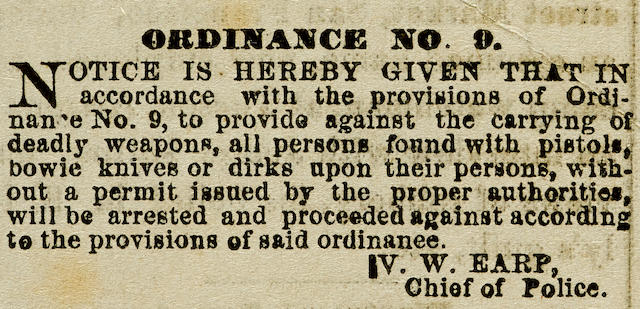Let’s go back in time, maybe not way back, but how about Arizona Territory after the Civil War. The “Wild West”! Guns blazing, stagecoach robberies, horse thieves, railroad thefts, bank heists!!! It was a lawless, chaotic, free-for-all for criminals to roam!!! Or was it?
While Arizona is indeed unique, its laws on carrying firearms were quite representative of most of the country at the time. The year is 1881, Tombstone, Arizona. Ordinance No. 9 was passed dictating that firearms are not to be carried in city limits and were instead to be turned in to the local sheriff or checked into the Grand Hotel, unless you had written permission from the government. If you’re familiar with westerns, no doubt you’ve heard of the Shootout at the OK Corral (which didn’t actually occur at the corral). This incident took place as the local lawmen of the area sought to enforce this new ordinance on the local rabble rousers. This resulted in a shootout, and the lawmen being tried for murder, though they were let off. Yeah, I’m talking about the Earp Brothers and their gang of big-headed, self-righteous gun control advocates, (never thought of it that way did ya?)

Dodge City, Kansas had passed a similar law in 1878. Most gun control laws were local ordinances and the feds had stayed well clear of it until the 1900’s. Alabama had a statewide ban, Louisiana as well, Kentucky even modified its Constitution in 1891 to allow the state to regulate arms after it lost a court battle [1]. The late 1800’s were a turbulent time for gun rights as our country continued to grow, expand, and settle new lands. We still had a lot of crud to work through after the civil war. International Affairs were running awry, the Spanish-American war broke out. Things were not quiet out in the west.

In Arizona, this limitation on the right to carry a gun grew from a local town ordinance in Tombstone, to a Territory wide law in 1901 [2]. Even after AZ became the 48th state in 1912, the prohibition on carrying in public without specific permission still stood and was upheld as late as 1994 [3]. As a result of this court case, the Arizona Legislature moved to revamp and overhaul the concealed carry permit system and passed ARS 13-3112 into law establishing a Shall Issue Permit standard for issuing licenses to carry concealed weapons in AZ [4].
This new law required gun owners to complete a two-day (16 hour) class, written by the Department of Public Safety, taught by DPS approved instructors, teaching them when the can and can’t use force, how to shoot, firearms safety, etc. They also had to pass a background check, submit fingerprints, and fulfill a list of requirements ranging from being 21 or older, to not being charged with a crime of domestic violence. It sounds like quite the process, and it was, but it was still better than the way things used to be. The way things used to be meant you had to be a law enforcement officer, or really good friends with the right ones to be allowed to carry a gun. Hardly a fair system indeed.

This method of Shall Issue licensing swept through the entire US during the 1990’s. Many states opted to move away from the discretionary (discriminatory) practice as lawsuits broke out over the arbitrary denial of permits by citizens who met every requirement, but the state decided to deny the permit anyway. About nine states have held onto their May Issue Permit schemes, keeping the hoops well out of reach, expensive, and vague. Hawaii, Maryland, New Jersey, and specific municipalities within California, Massachusetts, and New York are May Issue jurisdictions, they rarely grant permits, effectively becoming No-Issue jurisdictions.
Even still, the right to carry in the US has been growing. In the 2000’s many states began moving to a permit-less carry option while still having a CCW available for added perks. Take Arizona for instance, in 2010, after 16 years after having a CCW available, we enacted “Constitutional Carry” alongside still offering a CCW which allows Permit Holders a few select perks we discuss here. Since then, we now in 2021 have 21 states that have permit-less carry or “Constitutional Carry” options, rolling back over a century of carry bans in public spaces. It seems that states are increasingly moving towards the wild west. Though, maybe not so wild anymore, using FBI Data, we see that the violent crime rate fell 49% between 1993 and 2019 [5].
Will our rights to carry firearms in the US continue to grow, or will we let them erode away as we did 140 years ago?
- Section 1, Kentucky Bill of Rights, Constitution of Kentucky, as Ratified on: August 3, 1891, and revised September 28, 1891. (https://apps.legislature.ky.gov/law/constitution)
- ARIZ. PENAL CODE § 426 (1913); REV. STAT. ARIZ. TERRITORY, ARIZ. PENAL CODE § 382 (1901)
- State v. Moerman, 895 P.2d 1018, 1022 (Ariz. Ct. App. 1994)
- H.B. 2131, 41st Leg., 2d Reg. Sess. (Ariz. 1994) (enacted); ARIZ.REV. STAT. ANN. § 13- 3112 (2019)
- Gamlich, John (November 20, 2020), Retrieved from: https://www.pewresearch.org/fact-tank/2020/11/20/facts-about-crime-in-the-u-s/
